Homemade Mayonnaise is so easy to make! It tastes fresh, delicious, and it’s healthy! Cultured, it keeps for months in the refrigerator too.

This post contains affiliate links. As an Amazon affiliate, I make a small commission at no extra cost to you if you make a qualifying purchase. See my full disclosure here.
Homemade mayonnaise is so quick and easy to make and uses all natural ingredients and no weird preservatives. It tastes awesome, and you’ll never miss the stuff from the grocery store!
In fact you may never buy it again, because if you ferment your mayo, it can last for a month or more in your refrigerator. Make this delicious mayonnaise with healthy oil to use on your next sandwich, to make ranch dressing, potato salad, and anything you use store-bought mayo for. And you’ll know that this is good for you and delicious. Hey, let’s make some!
I love mixing homemade mayo into my fermented coleslaw with root vegetables (garden-slaw) for a probiotic, and nutrient-rich salad. Try also fermented eggs, and make probiotic deviled eggs or egg salad with them using this mayo. To make a great ancient grain sandwich bread, check out my easy sourdough kamut and einkorn bread, and if you love a good rye, try this easy, lazy way Sourdough Rye Bread or Sourdough Seeded Rye Bread. For more fermented food ideas, try my popular lacto-fermented tomato salsa and incredibly delicious fermented onions!
Why Make Homemade Mayonnaise From Scratch
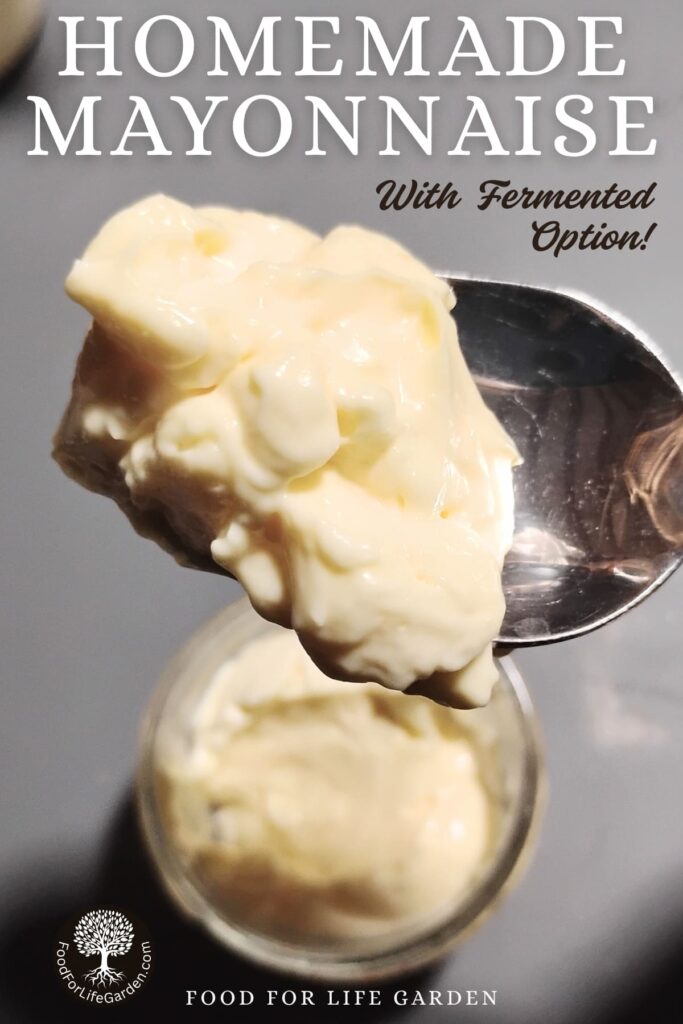
If you love mayonnaise on your sandwich and in your salads, you may have felt a pang of guilt about using too much of that store-bought version, that you know is not exactly great for your health. I know I did! Made with unhealthy soybean oil and added preservatives with weird names, it’s not a clean and healthy condiment.
I had stopped using commercial mayo for a long time to avoid unnecessary inflammatory fats and GMO ingredients. But then I learned how easy it is to make your own mayo from scratch and be able to control what goes in it.
You know, mayonnaise can be healthy and good for you. Replace the soybean oil with healthy, organic avocado oil, and skip the chemical preservatives and you will actually have a health food that you don’t need to feel bad about using often.
I mostly use mayo during tomato season. A pan-fried slice of sourdough bread with fresh made mayo, vine-ripened, juicy Brandywine tomato and some basil or pesto? Oh Ja! Bring it on!
Making homemade mayo is so much easier than you might imagine, and with my no-fail method, it’s so fun to make too. It is no harder than whipping cream or making a smoothie. So let’s make some great tasting, fresh mayo and replace those undesirable ingredients with healthy ones. And fermenting it makes it last for a month or longer in the fridge without chemicals. You’ll never buy store-bought again!
Why You’ll Love Homemade Mayonnaise
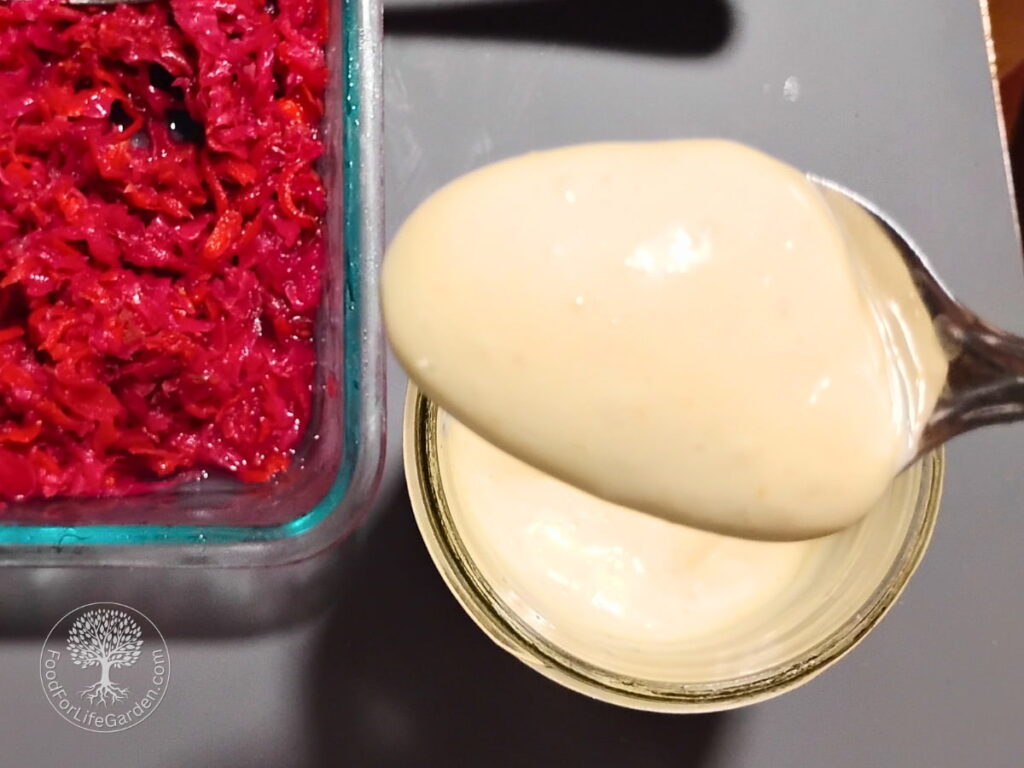
- It tastes great! It has a fresh flavor that you don’t get in store-bought.
- It’s easy to make with what you have on hand already. Much quicker than running to the store.
- Making it at home turns mayonnaise into a health food with the right ingredients. You have control over what goes in it.
- Homemade mayonnaise is a good source of healthy fats and omega-3 fatty acids, if you choose a healthy, anti-inflammatory oil.
- You can use whole eggs or just yolks depending on your preference.
- Make a traditional mayo with just eggs, oil, mustard, and salt, or add other flavorings.
- You can change the flavor by adding some fresh garlic or garlic powder, cayenne pepper, paprika or other spices.
- Keep refrigerated and it’s good for about a week. If you want to keep it for longer, you can ferment it and make it even healthier at the same time.
- It’s great as a topping on so many things like sandwiches, baked potatoes, french fries, and as a dip for vegetables.
- It is a great ingredient in salad dressings, ranch dressing, deviled eggs, egg salad, coleslaw, waldorf salad, potato salad or macaroni salad.
- Mix into fermented garden-slaw for a great creamy probiotic side-salad.
Tips For Making Homemade Mayonnaise
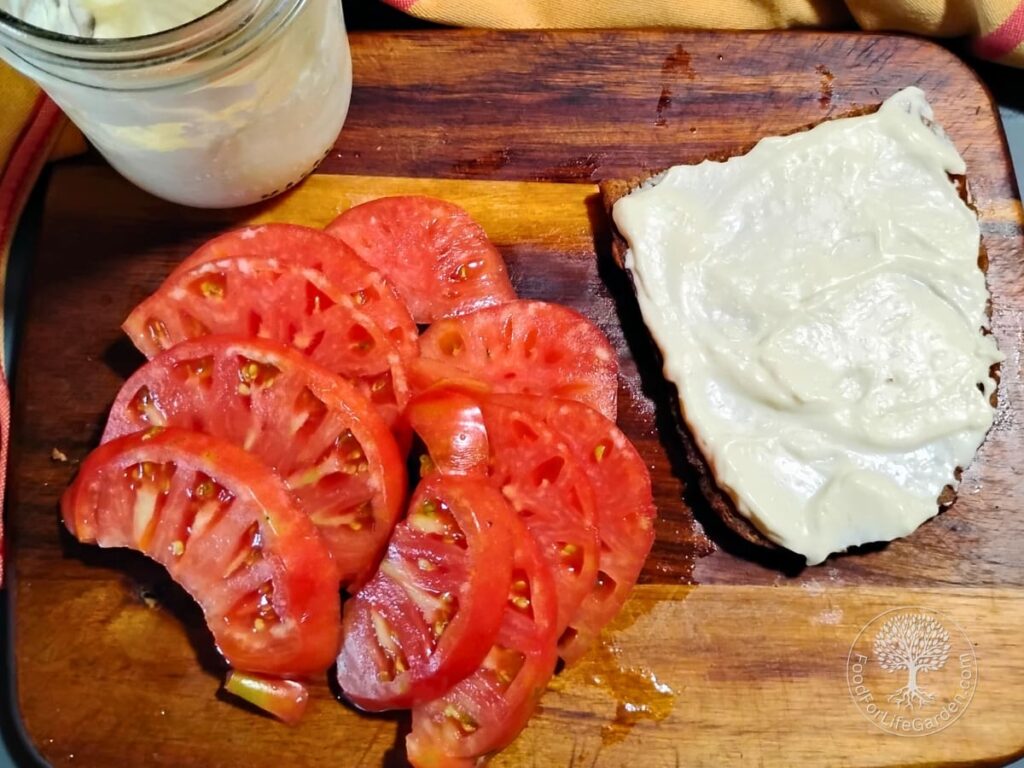
- Use all ingredients at room temperature.
- Be aware that using extra virgin olive oil could possible add a bitter flavor to your mayo.
Blending olive oil at high speeds in a blender can damage the fatty acid coating from polyphenols, which are naturally present in olive oil. These polyphenols have a bitter flavor and that can become noticable when olive oil is treated this way.
But not all olive oils are the same. This is mostly an issue with olive oil that contains a high amounts of polyphenols. Some high grade olive oils are high in polyphenols, others aren’t.
So if you are intent on using olive oil in your mayo, and plan to make a huge batch for a party salad, maybe make a small amount first, taste it and if it tastes good, use the same ingredients to whip up the large batch.
So if you make your mayo and find that it has a bitter flavor, your oil might be the culprit. If yours mayo is bitter, then try a different brand olive oil, or use one of the other healthy oils that do not cause bitterness, such as avocado or coconut oil. Then you can stir in up to a quarter cup of the EVO after blending for flavor.
- Likewise, blending garlic at high speeds can also add a bit of bitterness to the mayo. (If you’d like to read more about high-speed blending of olive oil and garlic, check out this article).
In the case of garlic, you could use a garlic press or smash your minced garlic, and just stir the garlic into the finished mayo, or leave it out. I actually like my mayo without the garlic, as much as I love garlic, and add plenty of garlic to the food separately instead.
- Prepared mustard, or mustard powder with vinegar, is necessary for a successful emulsion and it is used in the original, traditional mayonnaise recipes. This is not an optional ingredient, it helps to stabilize your mayonnaise.
- You can make this with a food processor, but it may not turn out as well and it’s not fail-proof. If you want to try it, add all the ingredients, except for the oil into the bowl of a small food processor. Process till light and fluffy on high. Start dripping olive oil into it while the blades are running. One drop at a time and increasing the amount as you go, very slow.
Culturing Your Mayo For Extended Shelf-Life
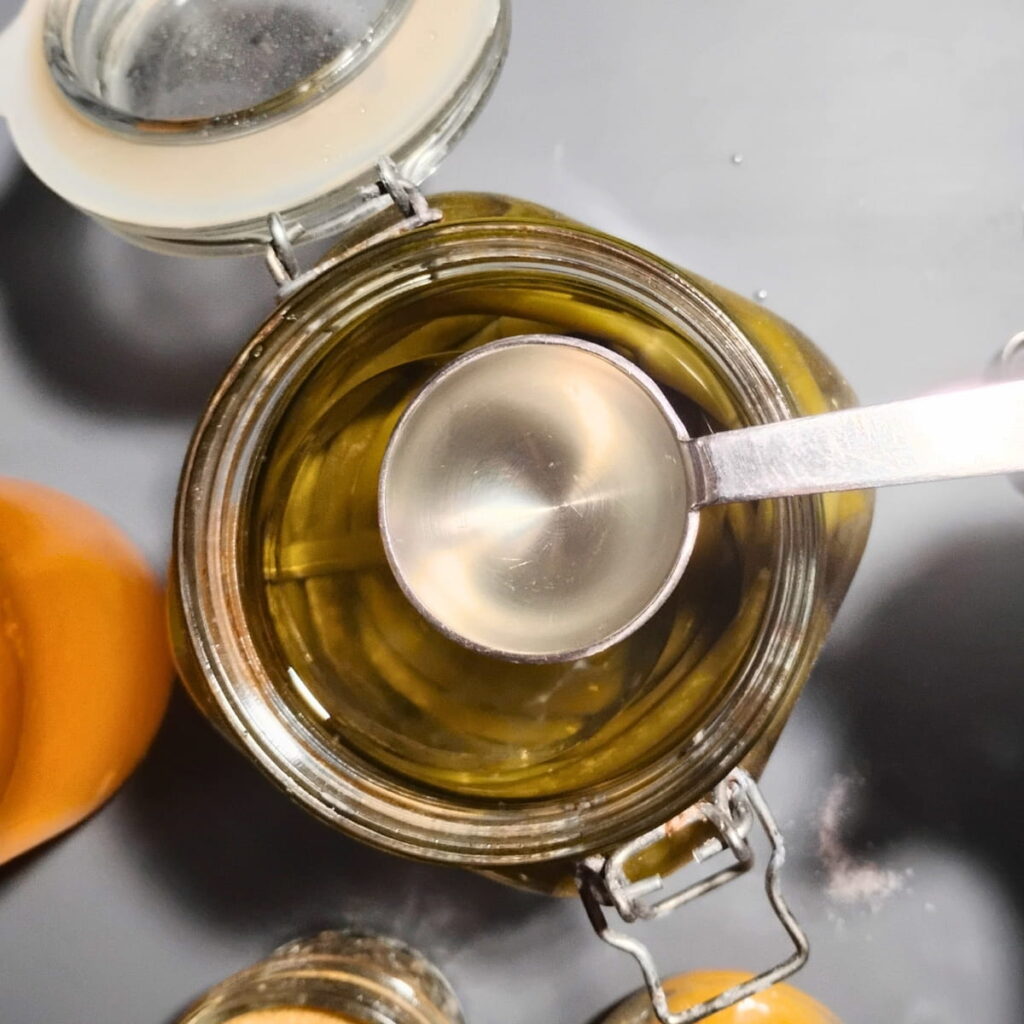
Traditional homemade mayonnaise will have a shelf-life of about a week at most in the refrigerator. However, with just an easy fix, involving one extra ingredient you can preserve your mayo for a month or more. And you’re adding probiotics and extra nutrients to your already healthy mayo. Now you’ve got a super-healthy mayo, how awesome is that!! With this hack, you can ditch your commercial mayo for good. Make a bunch when you have the time and then it’s there for you anytime you need some even when you’re in a hurry!
When culturing your mayonnaise, there are several options for your starter culture.
Yogurt whey: The easiest to find is probably yogurt whey for most people. You can find yogurt in any store. Just be sure to get unflavored yogurt that specifies that it contains live bacteria. Drain a spoonful of the watery whey, and add it to your mayo.
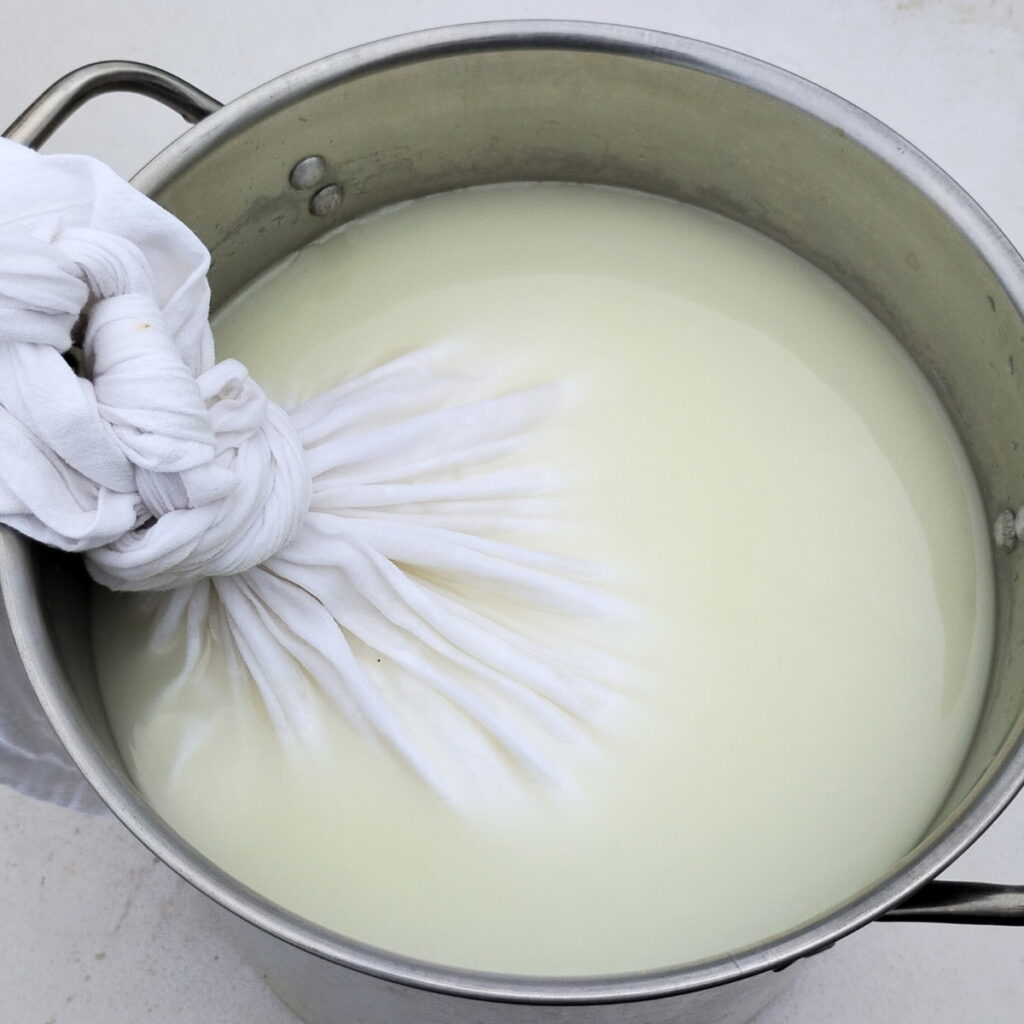
Cheese whey: Use whey from cultured cheese such as quark cheese or chevre. Salted cultured whey is ok, but then you might need to cut down on the salt in the basic recipe. Whey from cooked cheeses such as queso fresco or ricotta won’t work.
Water kefir or kombucha: These SCOBY based cultures are fine to use in your mayonnaise if you have them on hand
Fermentation liquid: Use the liquid from an active fermentation such as sauerkraut juice, fermented dill pickles, or fermented onions. I used my fermented garlic scapes liquid today.
Let’s Make Some Homemade Mayonnaise!
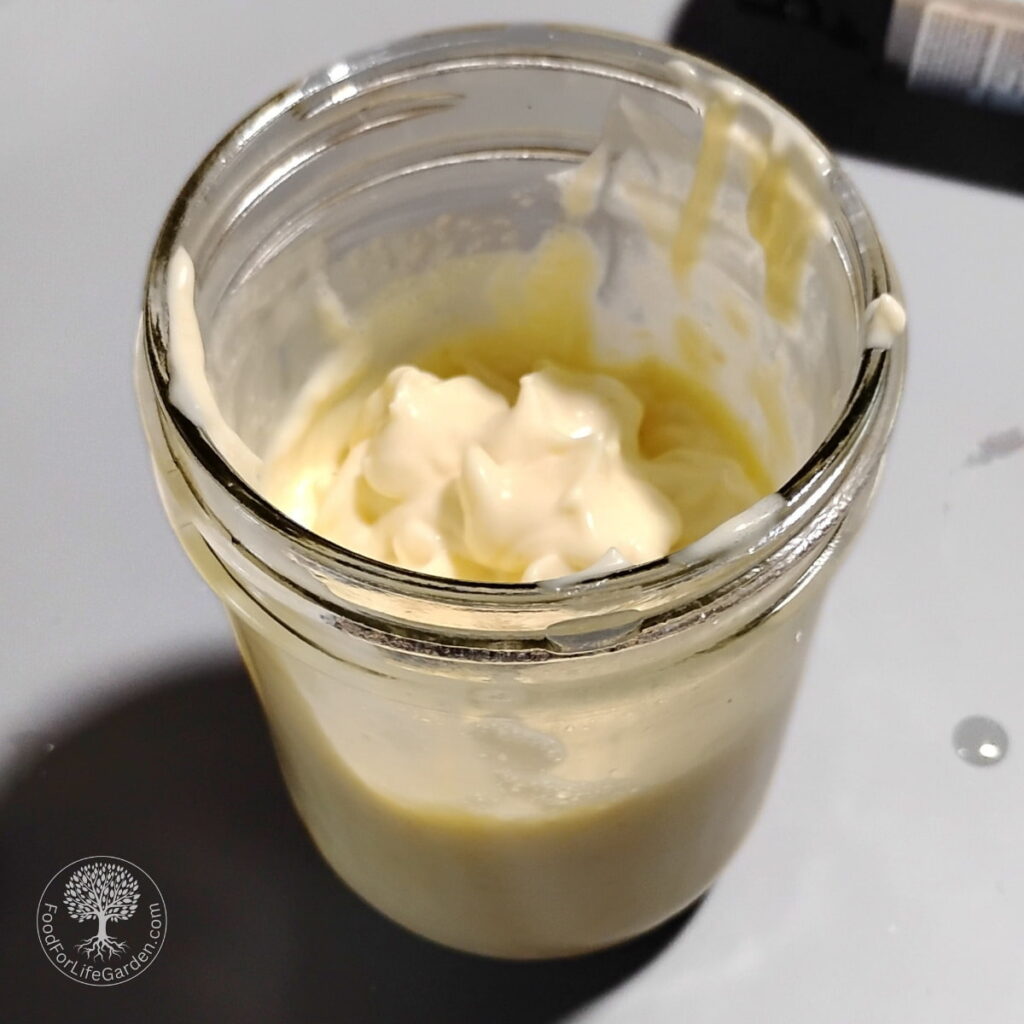
Equipment
A pint size wide mouth mason jar – Or use the tall, skinny blender container that came with your immersion blender.
Immersion blender – This recipe is designed to work with an immersion blender. If you make it with a hand mixer or a food processor, it may not turn out right
Ingredients
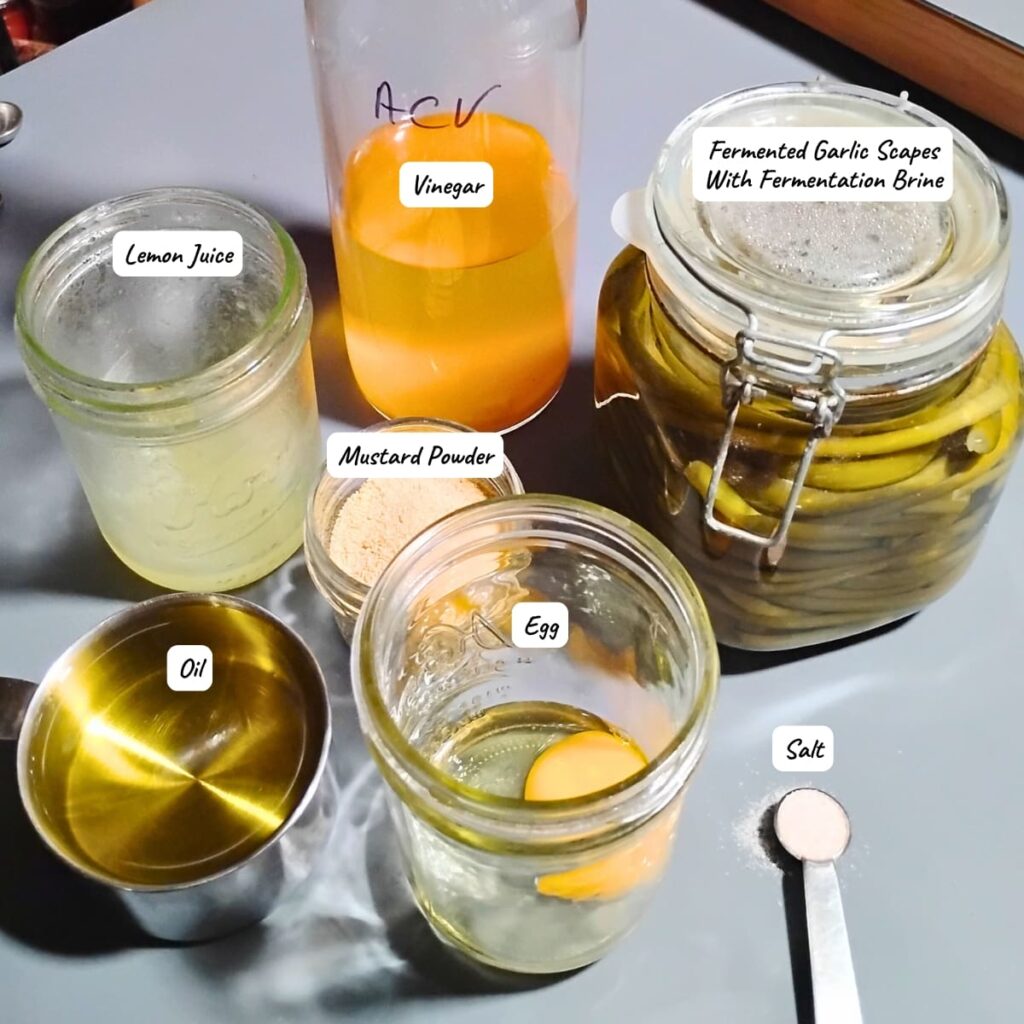
I always recommend choosing organic ingredients to support better health and to reduce toxins and damaging chemicals in the body.
Basic Ingredients
Whole egg or yolks – using just yolks will yield a richer mayo, but I like to just use a whole egg for less trouble and to me the mayo tastes plenty awesome this way. If you use just yolks, use two instead of the one whole egg. Use the freshest eggs you can get, at room temperature. And opt for pasture raised eggs if possible for the healthiest eggs and the best nutritional profile.
Mustard, prepared or powdered – This is necessary to stabilize the mayonnaise. Don’t skip the mustard! Use regular or dijon, which has a better flavor, however you won’t really taste it in this recipe. If you use powdered mustard, add a teaspoon of vinegar along with it. Learn how to make your own vinegar here.
Lemon juice – Gives your mayo a bright flavor, but you can use vinegar instead.
Avocado oil – This is my preferred, fairly neutral flavored oil for this recipe, but you can try fractionated coconut oil as well. To do the best for your health, try to stick with healthy oils and avoid those toxic and inflammatory oils that are plentiful on grocery shelves. Here is a great article on choosing healthy, anti-inflammatory oils. And learn why I don’t use olive oil for mayonnaise here.
Salt – I prefer to use Redmond’s Real Salt for the extra essential minerals it contains, or you can use Himalayan pink salt, Celtic sea salt, or other unrefined, additive-free sea salt. I don’t recommend it, but table salt works too.
Optional Flavorings
Pepper (optional) – A few pinches of pepper will round out the flavor and if you use fresh ground pepper, it helps the body to better absorb any nutrients in your food.
Starter culture (optional) – Adding a tablespoon of whey or fermentation brine will act as a starter culture for fermenting your mayonnaise. Culturing mayonnaise can keep it fresh for a month or longer. See also my paragraph on culturing mayo and choosing starter cultures.
Cayenne pepper (optional) – If you’re a hot head like me, of course this isn’t optional, but it is for anyone else 😜.
Garlic clove (optional) – As much as I love garlic, I don’t like to add it to my mayo. I do add it generously to all my foods though and will add some smashed garlic to a salad dressing made with mayonnaise. But if you like, mince some garlic and add it to your mayonnaise. Just be aware that a high speed blender may make your garlic taste a little bitter if you add it at the beginning. Alternatively, you could add smashed garlic after blending and just stir it in.
Ingredient For Natural Preservation Of Mayo
Starter culture (optional) – Choose your starter culture here
Instructions For Homemade Mayonnaise
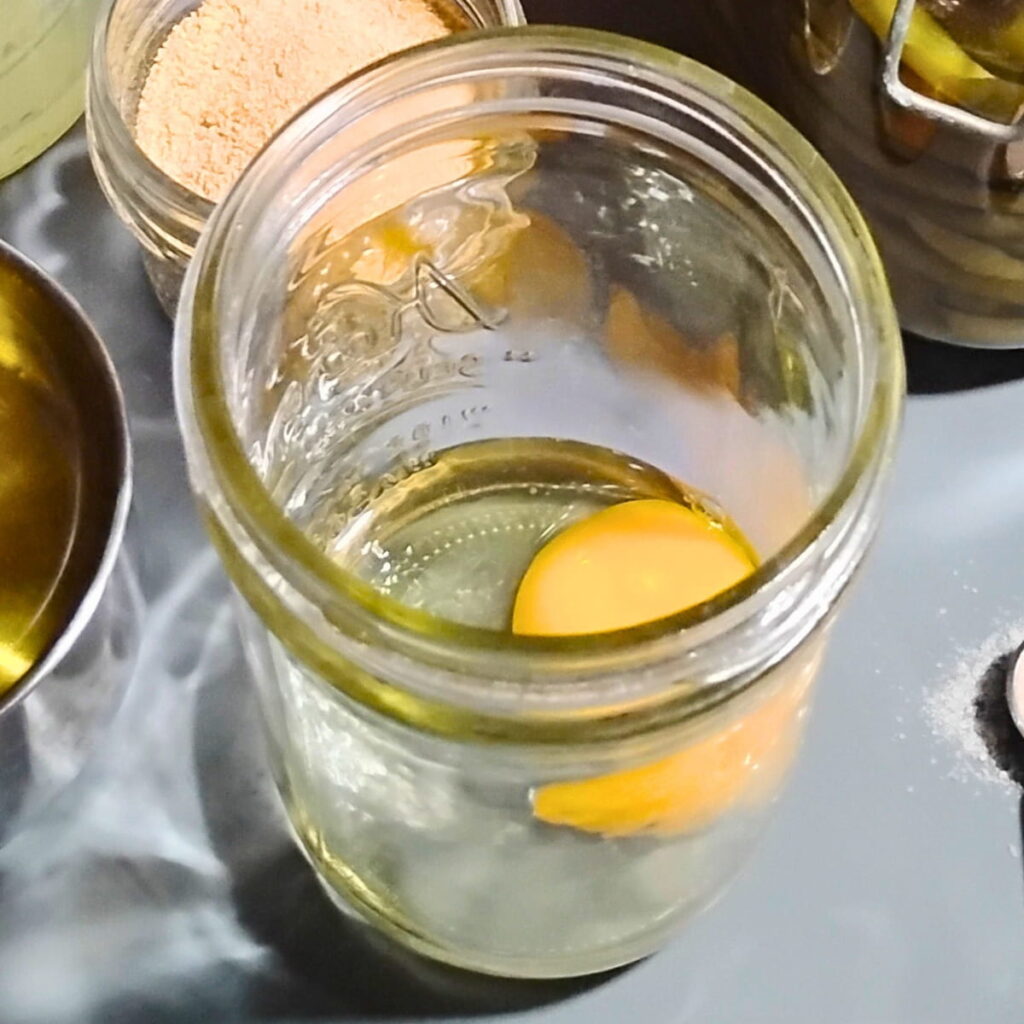
Drop the whole egg or the yolks into the mason jar.
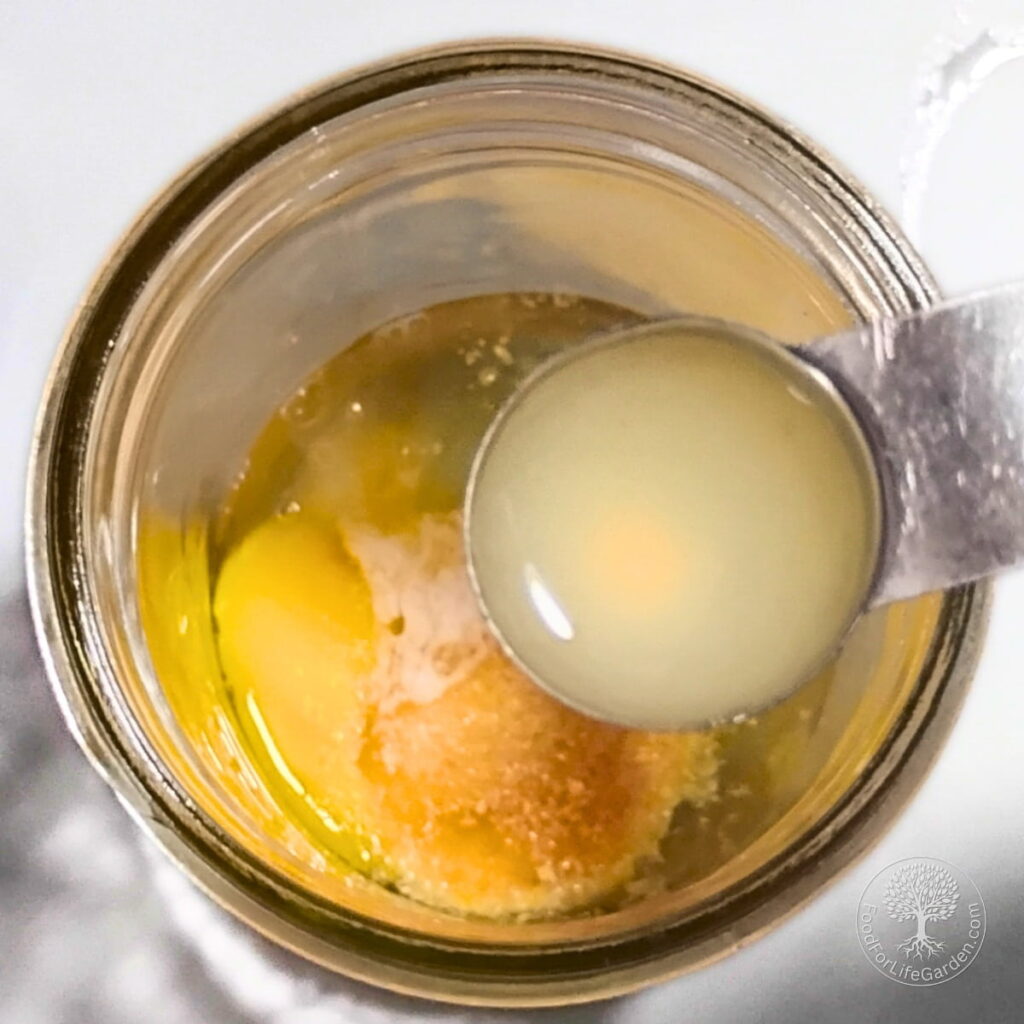
Add prepared mustard (or ground mustard powder and vinegar), lemon juice, salt, and desired flavorings. And add the starter culture if you are planning to ferment your mayonnaise.
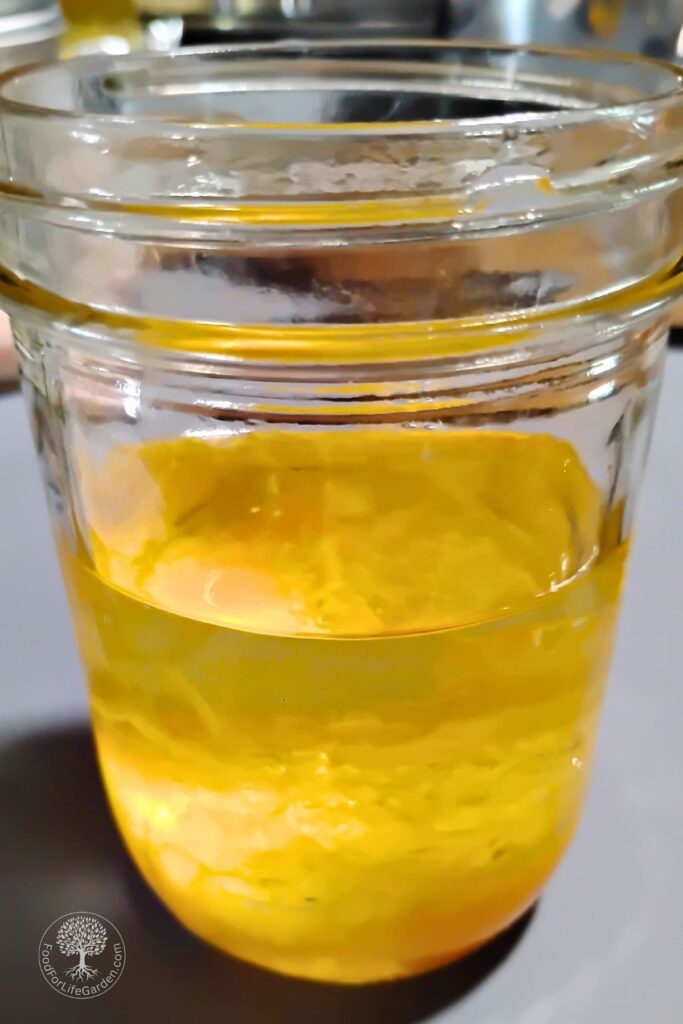
Pour the oil over it and let everything settle for a few seconds.
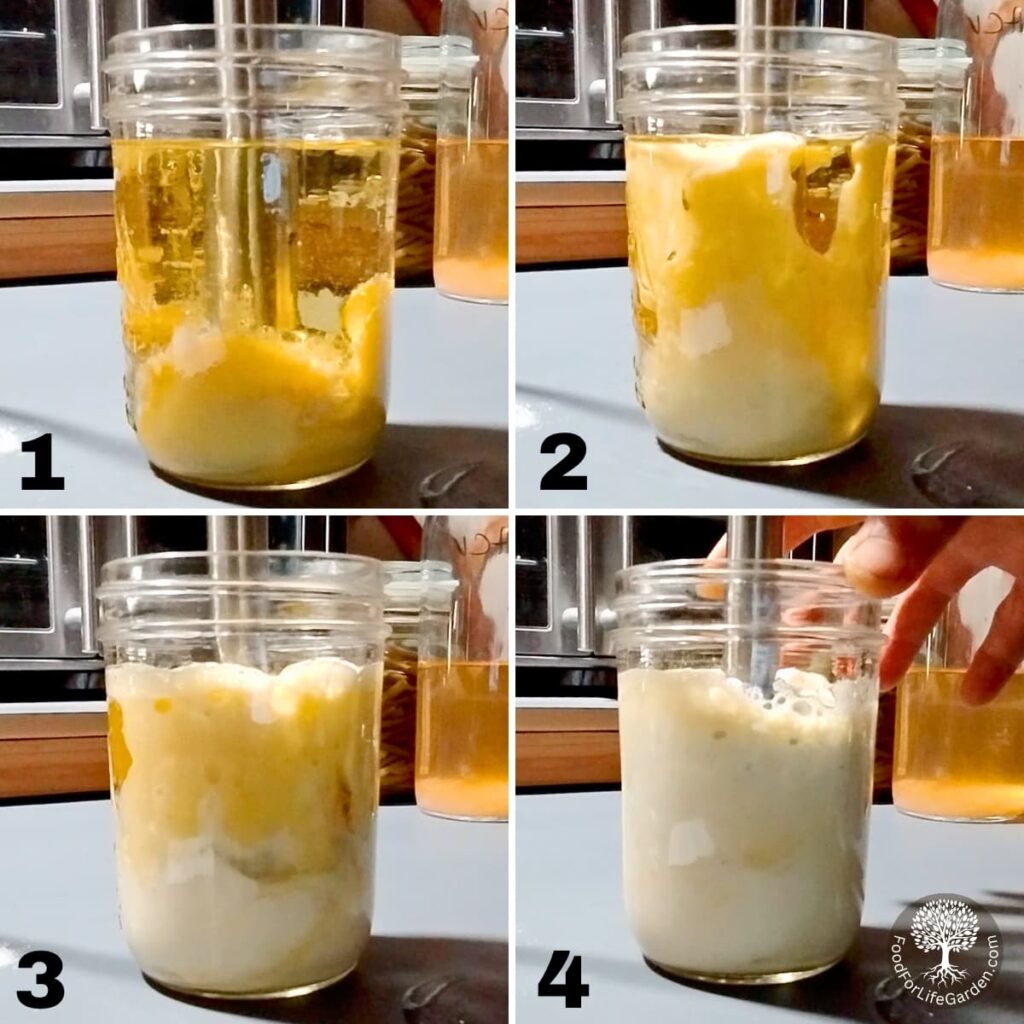
1. Set your immersion blender into the jar, touching the bottom. Start blending on high speed.
2. Once you see the bottom ingredients turn white, start to slowly raise your immersion blender upwards to incorporate more of the oil.
3. Keep going till you get to the top of the mix.
4. Move up and down once or twice then turn off and remove your blender.
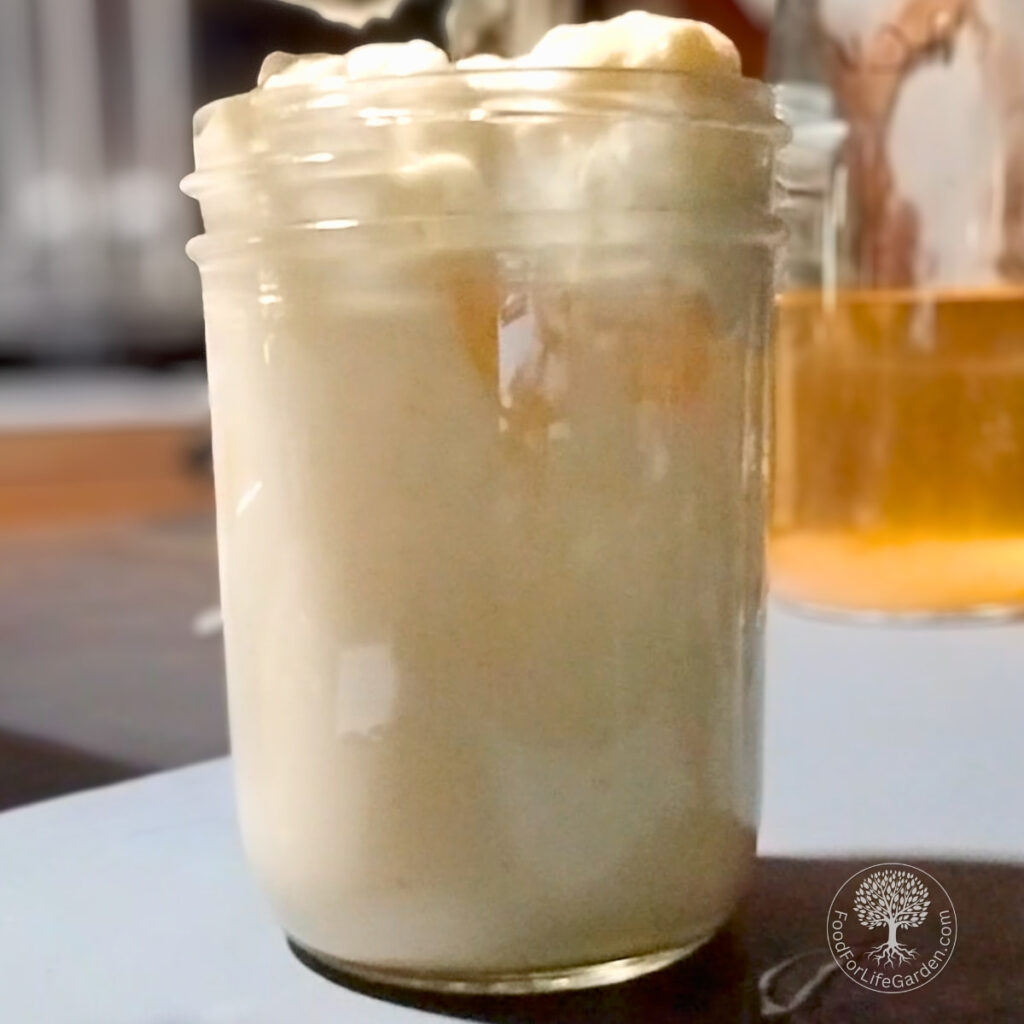
And that’s it. If there is a little oil floating at the top that’s ok, just give it all a quick stir.
If you don’t use it right away, refrigerate it and it will keep for up to a week.
For longer storage (a month or more), and if you added the starter culture previously, ferment it for 8 hours at room temperature and then refrigerate. This will prolong shelf-life in the refrigerator and add probiotics and more flavor.
Troubleshooting
What to do if your mayo separates?
I have not had an issue, but if you do, here is what others recommend:
Place an egg into a pint jar and blend it briefly. Then add your broken mayo by the spoonful while blending.
Another thing to try is to add a tablespoon of boiling water to your mayo while blending.
Why Does My Mayonnaise Taste Bitter?
If you blended your mayo with olive oil, the polyphenols that are contained in the olive oil can lend a bitter flavor to your mayo because of the blending action. Use a neutral oil such as avocado oil next time.
Garlic can also turn bitter when blended with high speed blades. Try adding your garlic after your mayo is all blended.
How To Use This Homemade Mayonnaise
Use it just like store-bought mayonnaise!
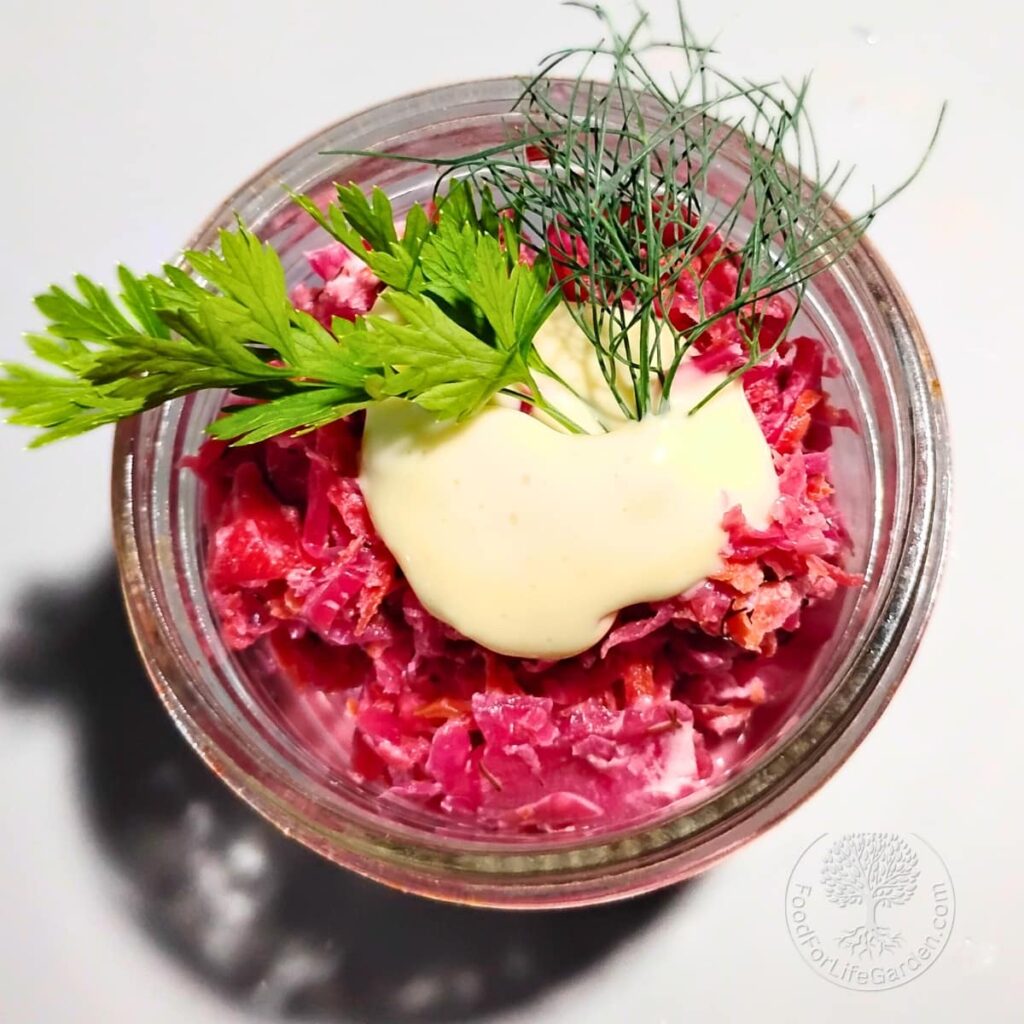
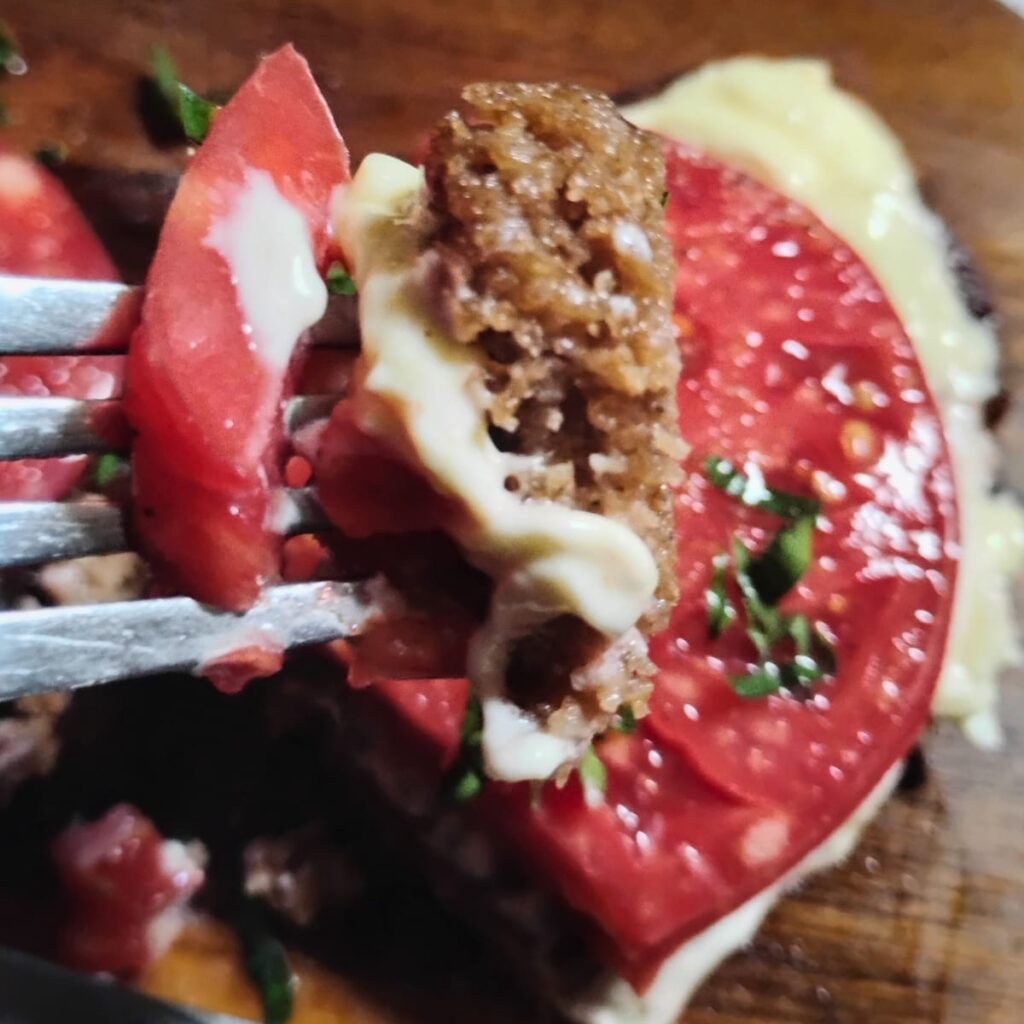
- Pile it on your sandwiches. I highly recommend a mayonnaise and sun-ripened tomato sandwich on a toasted slice of my easy Kamut and einkorn bread or Sourdough Rye Bread. So very tasty!
- Make a dip, such as a ranch dip, onion dip, or mayonnaise-based aioli
- Mix it into fermented coleslaw
- Make salad dressing
- Use for making deviled eggs
- Make potato salad
- Top your baked potato
- Serve with french fries
Enjoy Your Homemade Mayonnaise

If you love mayo, you’ll love this homemade version even better. Ditch the store-bought stuff and make your own at home for extra scrumptious sandwiches and salads. It tastes delicious, it’s so easy, and you can make it truly healthy, without strange preservatives and questionable to downright toxic oils. I hope you get to make this delicious mayo from scratch, and I’m certain you’ll never buy mayo at the store again. You’ll love how easy it is and how awesome it tastes!
I’d love to hear about it if you get to make this awesome homemade mayonnaise. Let us know your favorite way to use mayonnaise. And please don’t hesitate to ask in the comments if you have any questions!
Join the Food For Life Garden Community for more great recipes and homestead tips and ideas. I’m always adding new content. Don’t miss any new posts and learn more about my off-grid farm life.
Other Recipes You Might Like
Fermented Coleslaw – A cabbage and roots medley with fabulous coloring and awesome flavor. Packs nutritious punch and probiotic diversity.
Tabouli Salad – a delicious cold salad or meal, made gluten-free with quinoa and packed with nutrition and health benefits.
Awesome Uses For Whey – Save the whey! And use it in dozens of ways. You’ll find something to do with whey for every single drop. It’s nutritious, versatile, healthy, and makes great fizzy sodas!
The best Sourdough Rye Bread – Easy, lazy method that makes super delicious, moist, chewy rye bread to partner with your favorite cheese.
Sourdough Seeded Rye Bread With Spelt – If you are a fan of rye bread, you need to try this awesome seeded rye. Loaded with whole grain berries and seeds, awesome with cheese.
Kamut sourdough bread recipe Make your own delicious ancient grain sourdough bread. Tolerated by most, even many people with wheat sensitivity. Incredibly good toasted or pan-fried and with cheese or mayo and tomatoes!
Homemade Apple Cider Vinegar – This lovely vinegar is made from apple scraps, not the actual apple cider. But it is just as effective, easier to make and uses all those leftover apple scraps or ugly apples.
Fermented eggs – A probiotic, nutritious, delicious snack that you can keep in your refrigerator for several weeks. Try fermenting garlic scapes with your fermented eggs for great flavor!
Fermented Onions – Keep some onions ready to use on Sandwiches or to put on your salads. Zesty or plain, onions taste great when fermented, and you’ll get the benefits of probiotics.
Fermented Garlic – Lacto-fermented garlic paste is kind of a special food. It’s the ultimate convenience food and health supplement. But besides that, it gets better as it ages. Just like a fine wine.
Fermented Chili Paste – Here is a great way to preserve your end-of-the season harvest of green peppers. This paste will last all year in your refrigerator to use as a condiment, seasoning, or topping.
Fermented Cucumber Pickles – How to ferment your excess of cucumbers to enjoy all year long and with the added benefit of improving your gut health with probiotics.
Fermented vegetables – How to ferment your summer’s bounty to enjoy it all year long and with the added benefit of improving your gut health with probiotics. Learn the basic skill of fermenting any kinds of vegetables, learn about the benefits of fermentation and get the science behind it too.
Pin This Recipe For Later
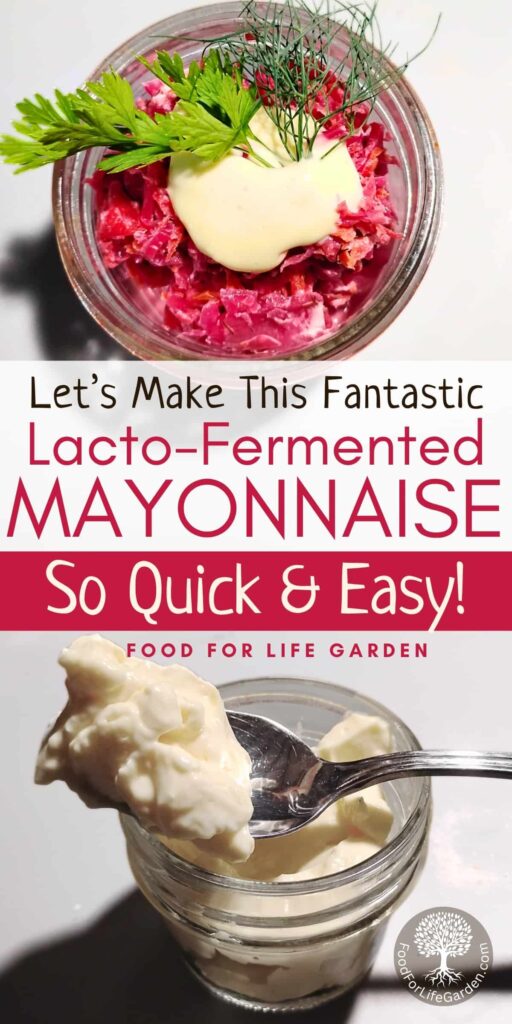
Shop This Post
Immersion blender
Redmond’s Real Salt
Himalayan pink salt
Celtic sea salt,
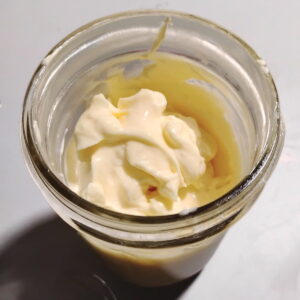
How To Make Homemade Mayonnaise
Equipment
- A pint wide mouth mason jar – Or use the tall cup that came with your immersion blender.
- Immersion blender
Ingredients
Basic Mayo Ingredients
- 1 whole egg – or 2 egg yolks for a richer mayo
- 2 tsp prepared mustard – Or 1/2 tsp powdered + 1 tsp vinegar
- 2 tsp lemon juice
- 1 cup avocado oil
- ¼ tsp salt
Optional Fermentation (Natural Preservation) Ingredients
- 1 tbsp fermentation brine, kombucha, water kefir, or active whey – only needed if you want to preserve the mayo for longer than a week.
Optional flavorings
- pinch pepper, ground
- pinch cayenne pepper, ground optional
- 1 garlic clove, minced optional
Instructions
- Drop the whole egg or the yolks into the mason jar.
- Add prepared mustard (or ground mustard powder and vinegar), lemon juice, salt, desired flavorings, and fermentation starter if you choose to use it.
- Pour the oil over it and let everything settle for a few seconds.
- Set your immersion blender into the jar, touching the bottom. Start blending at high speed without lifting the blender.
- Once you see the bottom ingredients turn white after about 15 seconds, slowly raise your immersion blender upwards to incorporate more of the oil.
- Keep going up till you get to the top of the mix, go up and down once or twice more, and turn off and remove your blender.
- If there is a little oil floating at the top that's ok, just give it all a good stir.
- If you're fermenting your mayo, at this point put a lid on it and leave it to ferment for 8 hours at room temperature and then refrigerate. This will prolong shelf-life in the fridge and add probiotics and more flavor.
Notes
Tips For Making Homemade Mayonnaise

- Use all ingredients at room temperature.
- Be aware that using extra virgin olive oil could possible add a bitter flavor to your mayo. Blending olive oil at high speeds in a blender can damage the fatty acid coating from polyphenols, which are naturally present in olive oil. These polyphenols have a bitter flavor and that can become noticable when olive oil is treated this way. But not all olive oils are the same. This is mostly an issue with olive oil that contains a high amounts of polyphenols. Some high grade olive oils are high in polyphenols, others aren’t. So if you are intent on using olive oil in your mayo, and plan to make a huge batch for a party salad, maybe make a small amount first, taste it and if it tastes good, use the same ingredients to whip up the large batch. So if you make your mayo and find that it has a bitter flavor, your oil might be the culprit. If yours mayo is bitter, then try a different brand olive oil, or use one of the other healthy oils that do not cause bitterness, such as avocado or coconut oil. Then you can stir in up to a quarter cup of the EVO after blending for flavor.
- Likewise, blending garlic at high speeds can also add a bit of bitterness to the mayo. (If you’d like to read more about high-speed blending of olive oil and garlic, check out this article). In the case of garlic, you could use a garlic press or smash your minced garlic, and just stir the garlic into the finished mayo, or leave it out. I actually like my mayo without the garlic, as much as I love garlic, and add plenty of garlic to the food separately instead.
- Prepared mustard, or mustard powder with vinegar, is necessary for a successful emulsion and it is used in the original, traditional mayonnaise recipes. This is not an optional ingredient, it helps to stabilize your mayonnaise.
- You can make this with a food processor, but it may not turn out as well and it’s not fail-proof. If you want to try it, add all the ingredients, except for the oil into the bowl of a small food processor. Process till light and fluffy on high. Start dripping olive oil into it while the blades are running. One drop at a time and increasing the amount as you go, very slow.

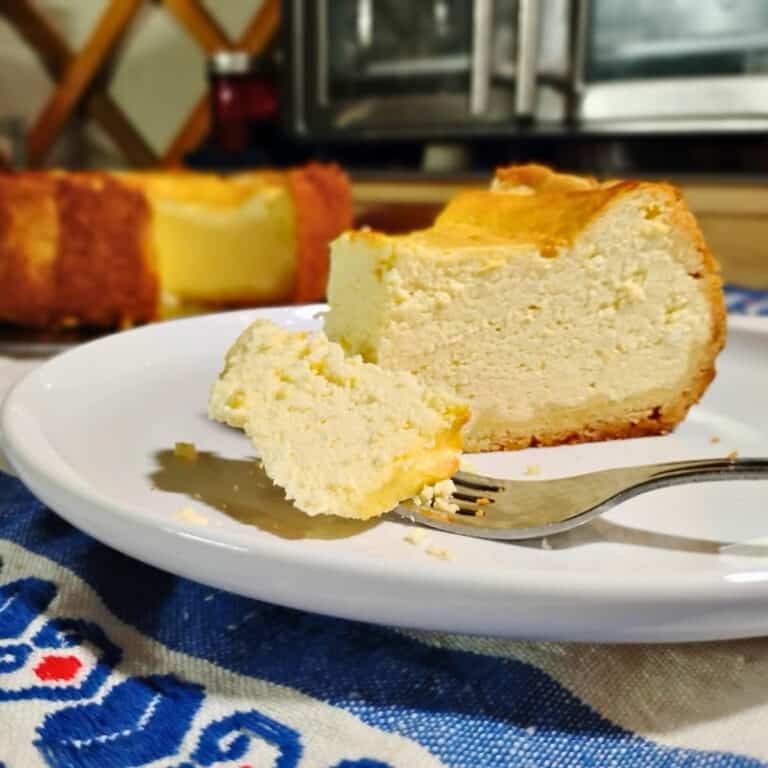
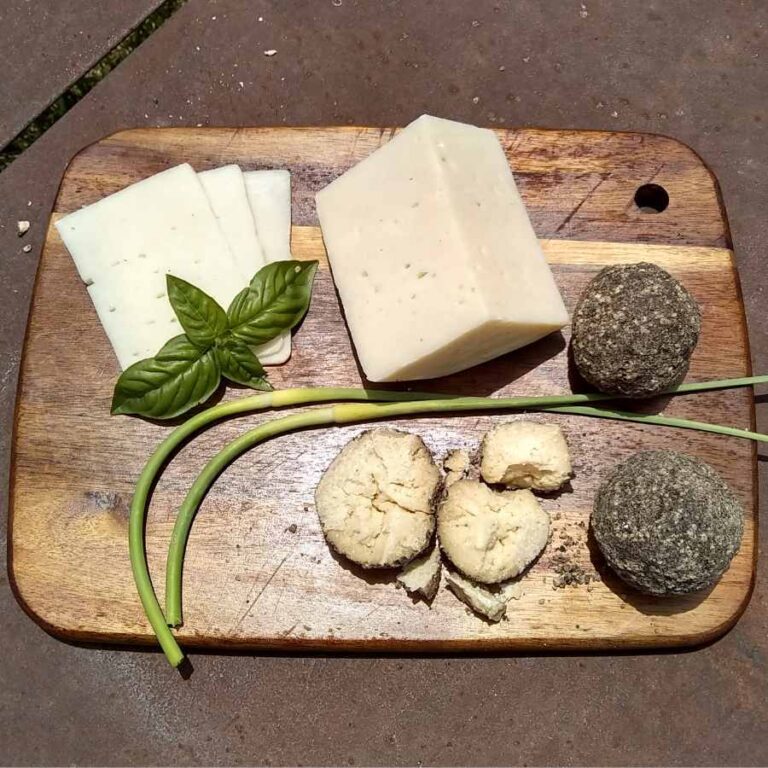
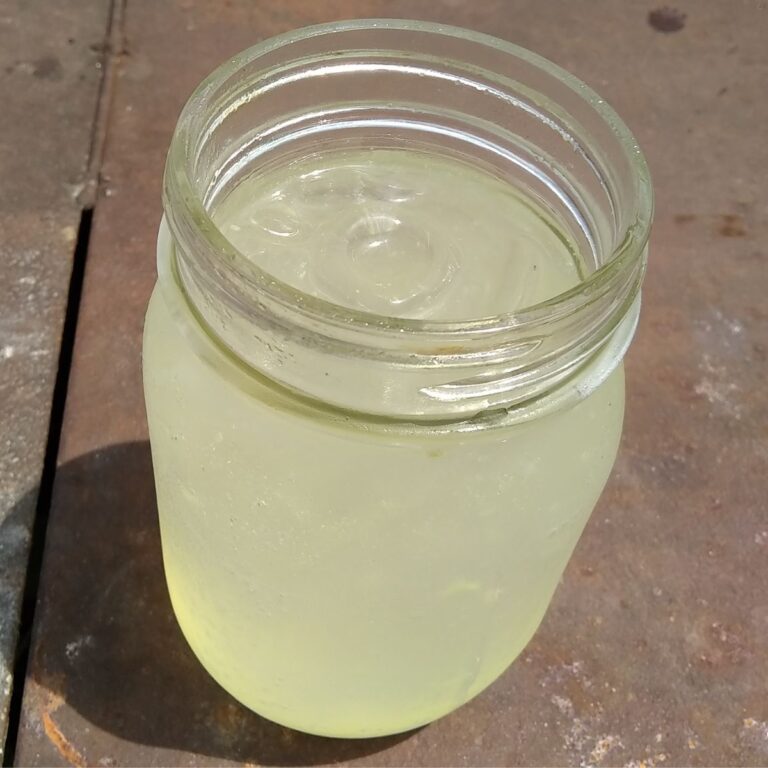
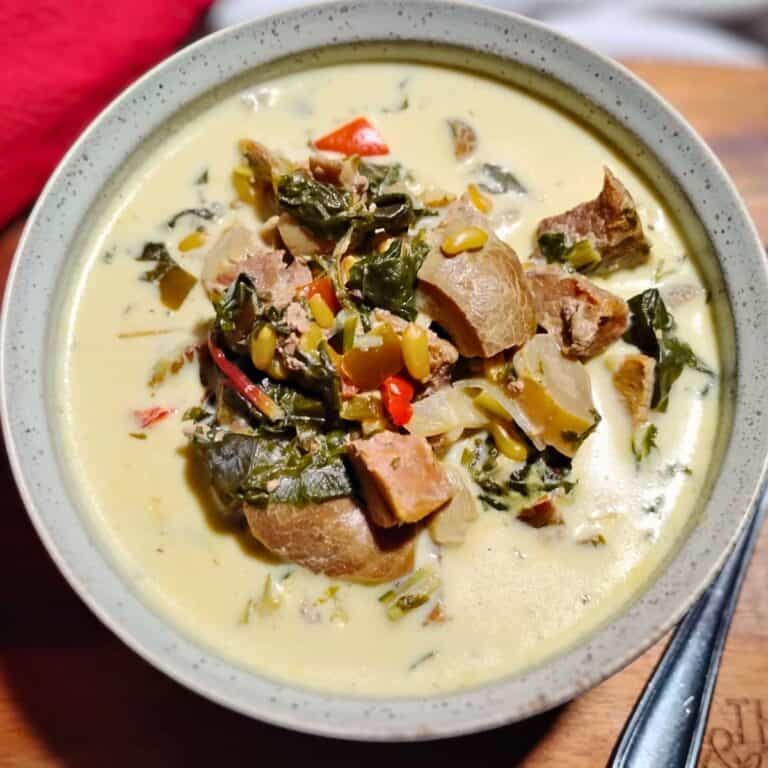
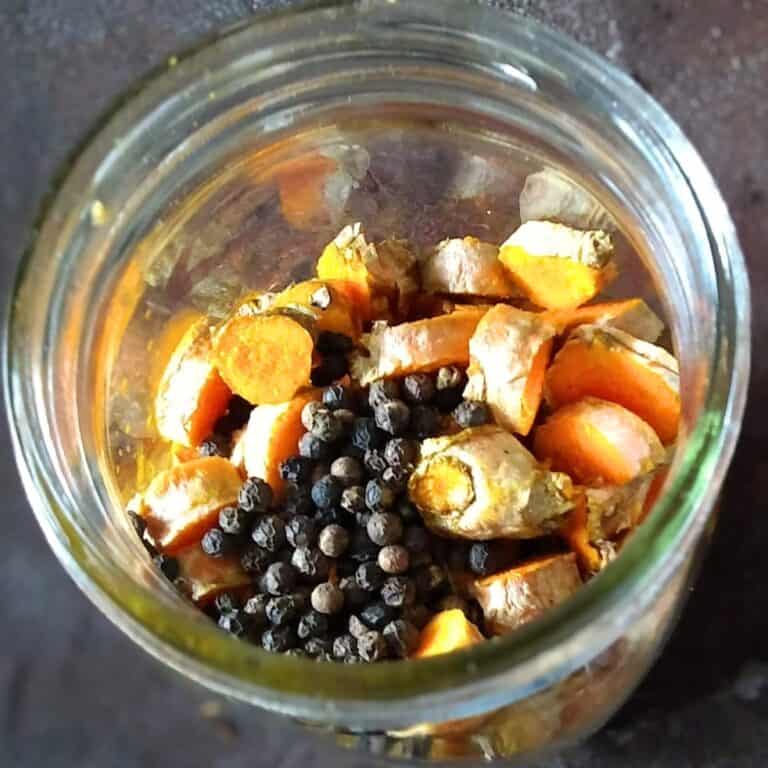
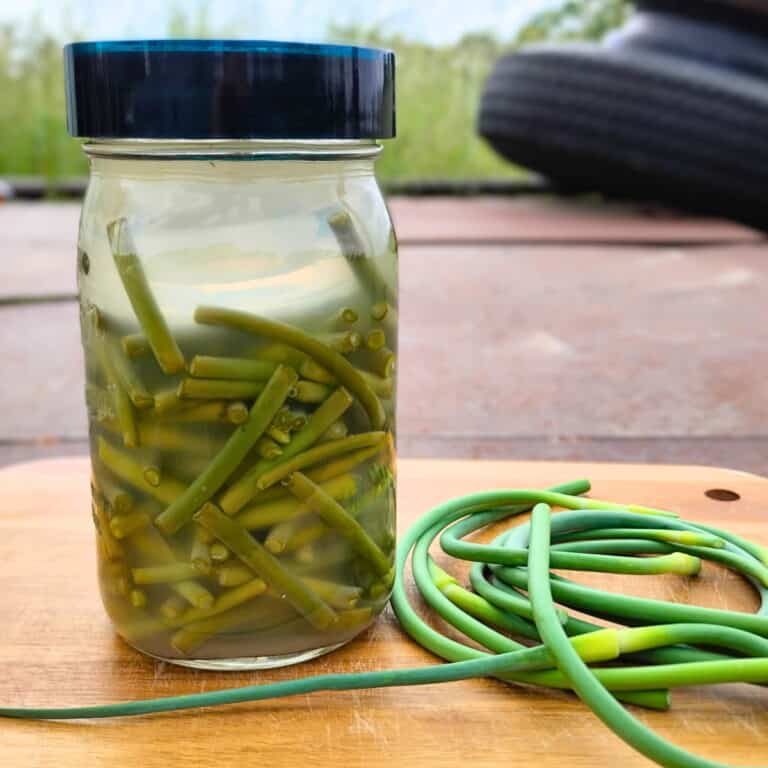
This looks extremely simple! I’ve tried to make homemade mayo in the past but it never turned out creamy like store bought. It was always kind of runny. Maybe I will have to try again!
Hey Mindy! Sorry about your bad experiences making mayo! I hope you’ll try my recipe, it has never let me down yet. Hopefully it will give you success too!
So true that the store bought mayo is just full of ingredients that aren’t great. You make this seem so simple and I’m always trying to switch out things one by one. Thanks for sharing!
That’s a good way to stay healthy, Alisha, and I’m glad you like my recipe. I hope you ge to try it!
I’ve been making homemade mayo with whey for a while now and I love how it turns out and how long it can last in the fridge! It’s also so easy to make! I love this recipe, thank you so much for sharing and for giving me so many good ideas to use this mayo 🙂
You’re welcome, and thank you for sharing this, Marta, I’m glad you love fermented mayo too, it is great stuff!
Thank you for another easy to follow recipe and tutorial! You always make things seem so much less complicated than one might think. Thank you for that! I always learn something new 😊
You’re so welcome and thank you for the kind comment, I appreciate it! 😍
I always make homemade mayo because my husband and son have soybean intolerances. We also have water kefir. I never thought to use the kefir to ferment the mayo so it would last longer. This is brilliant!
Glad you like this, Sarah and I hope you’ll get to try fermenting it!
Wow, Heidi! I have never heard of fermented mayo & now I want a batch! Great guude & recipe!
I’m so glad you like it, Penny and I do hope you’ll give this a try. It’s great!
I love adding in the fermentation!
It’s a small extra step for all the benefits you get, so worth it in my opinion!
This is so interesting! I’ll have to try this method with my ghee mayo!
Oh, ghee mayo sounds awesome. I’d love to hear how it turned out fermented!
What!!! You can ferment mayo?! I have learned so much from your recipes. Another great one, thank you!!
You’re welcome, so glad you liked it and thanks for visiting!
I’ve never made homemade mayo, but now I really want to!
Hey Megan! I hope you’ll give it a try. It’s so tasty and it’s really fun to make too!
I love fermented foods, but I’ve never heard of fermented mayonnaise. I will have to give this a try!!
Hey Lydia! Thanks for your comment, I’d love to hear how you like it!
I’ve always wanted to try making my own mayo but never did. Your post makes me want to actually try it!!
Hey Nikki! That’s awesome! I hope you do try it and I’d love to hear how you like it!
I’m not sure if I’m blending too long or not long enough! It doesn’t get very thick and separates (get oily) in my guys’ sandwiches. Help! It’s fermenting on the counter right now.
Oh, I’m so sorry Jacqueline, I was totally not able to tend to my comments sooner. Here is what might have given you trouble: Did you use all room temperature ingredients? Don’t turn on the blender until it sits at the very bottom of the jar. And then you need to keep the blender stick down until it starts to get white and comes together before you slowly raise the stick to incorporate the rest. I’m sorry that this was not working out for you and I sure hope that these tips help to make it a success next time.